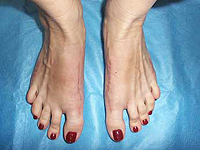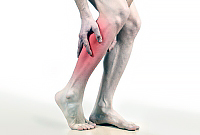Osteoporosis - the progressive disease of the bone tissue, in which the bones lose calcium, and with it the strength. Bones become fragile, which may result in frequent fractures - even with minor injuries.
Content
Why bones are destroyed
Human bone - a living organism in which two types of cells live and fight: Destroyers and builders. Destroyer cells are attached to the surface of the bone and distinguish acids and enzymes that destroy the bone. At the same time, calcium, necessary for the work of many vital organs, is distinguished from bones in the blood flow. As a result, the blades (lacuna) are formed on the surface of the bone, and the destructors' cells are dying.
Builders' cells rush into these depressions and create the basis of a special protein where later «Merrate» Calcium, which is captured from blood. Lakuna is filled with new bone substance. The process of building a new bone occupies approximately 3 months. In a healthy person p Osrusion (resorption) and bone construction (osteogenesis) are in full equilibrium.
Osrusion (resorption) and bone construction (osteogenesis) are in full equilibrium.
With osteoporosis, the activity of the destructors cells is sharply increasing. A multitude of destruction sites are formed in the bone, and builder cells do not have time to fill all the depressions with a new bone substance. Destructive bone loses calcium, thinning and becomes fragile.
If you look at the bone into the microscope, it will seem that numerous holes are formed in the bone of bones. Hence the name of the disease - osteoporosis (translated from the ancient Greek - «Porous bone»).
When bones are destroyed
The supply of calcium in the bones of the human skeleton after the 30th age begins to decrease. At first, the loss of calcium bones is almost invisible. In the feminine body, the activity of destroyers controls the estrogen sex hormone, which monitors the presence of calcium in the bone and ultimately - its safety. At the occurrence of menopause estrogen ceases to form in the female body, and the destructors begin «uncontrolled» bone.
Bone destruction is particularly intensified in the first 3 years of menopause. At this time, every year is lost near a kilogram (!) Bone masses (and on average, an adult skeleton weighs 20-25 kg). That is, after the cessation of menstruation, the woman loses annually near the kilogram of bone mass!
After 3-5 years of menopause loss of calcium bones decreases somewhat, but still remains quite significant.
There are risk factors that lead to irreversible destructive processes in the skeleton and young age. These include low body weight, fragile build, low mineral density of bone tissue, fractures, some diseases of the endocrine system, in particular the thyroid gland, operations on the stomach and intestines. Eating food with insufficient calcium content, vitamin D deficiency, reception of hormonal drugs, a sedentary image. Life, long-term (more than 2 months) bed.
The dangers of osteoporosis
Osteoporosis cunning: For a long time, the disease proceeds asymptomatic, does not show itself. Sometimes the only manifestation is back pain with long standing, which decreases when a person takes a horizontal position.
The most serious and typical consequence of osteoporosis is the fracture of the hip neck, which often happens in the elderly.
Symptoms of ostepoosis
Independently recognize osteoporosis in the early stages difficult. The alarm is night cramps in the legs and feet, pain in the bones, pain in the lower back, the fractures of the hip, spine, wrists or other parts of the skeleton, the widow hump - the curvature of the spine forward, reduce growth (by 2-3 cm per year), fragility or softening nails, premature poses. 
Diagnosis of osteoporosis
Modern methods of examination are used to diagnose the disease - Densitometry and radiography. Densitometry allows you to determine the mineral density of bone tissue and thus predict the risk of fractures and identify the disease at an early stage. X-ray allows you to make a diagnosis already at later deadlines in the presence of fractures.
Prevention and treatment
The prevention of osteoporosis must be started already in 25-30 years. You should refuse to use alcohol and coffee, smoking, regularly carry out exercise, more walk, move. Treat osteoporosis is much more efficient at an early stage, without waiting when he declares itself a fracture. When a disease is detected, calcium and vitamin D are required, as well as in mandatory preparations that stop bone destruction.
When taking calcium calcium drugs in the blood, calcium concentration increases. Calcium Concentration - Permanent and Important For the Body. «Lish» His calcium does not happen: part of it is inhibits, placing in the bone, and the part displays with the help of kidneys. If the preparation saturated with calcium includes vitamin D3, it improves the transportation of calcium in the bone.
However, in the massive destruction of the bones due to osteoporosis in the bone, a sufficient amount of calcium is received. Builders' cells do not have time to fill them all the depressions. Therefore, the reception of ordinary calcium preparations, even with vitamin D3, is not able to stop the destruction of the bone.
The most powerful protection against bone destruction provides special medicinal substances - bisphosphonates. In their structure, they are similar to mineral in the bone - hydroxyapatite. Therefore, when taking inside, these substances quickly fall into the bone - it is in those sites where the destruction goes, and a protective film is formed there. As a result, the destructive cell is dying, and builder cells continue to work. The equilibrium between the destruction of the bone and the formation of the new is restored. Calcium supply in the body stabilizes and even replenishes.
The most modern bisphosphonates are effective in only one tablet per month. The previous generation of bisphosphonates implies daily or weekly reception.
To restore bone strength, it is necessary to regularly take bisphosphonates, for a long period - 3-5 years. In this case, the bones achieved a sufficient degree of mineralization and get rid of numerous.









